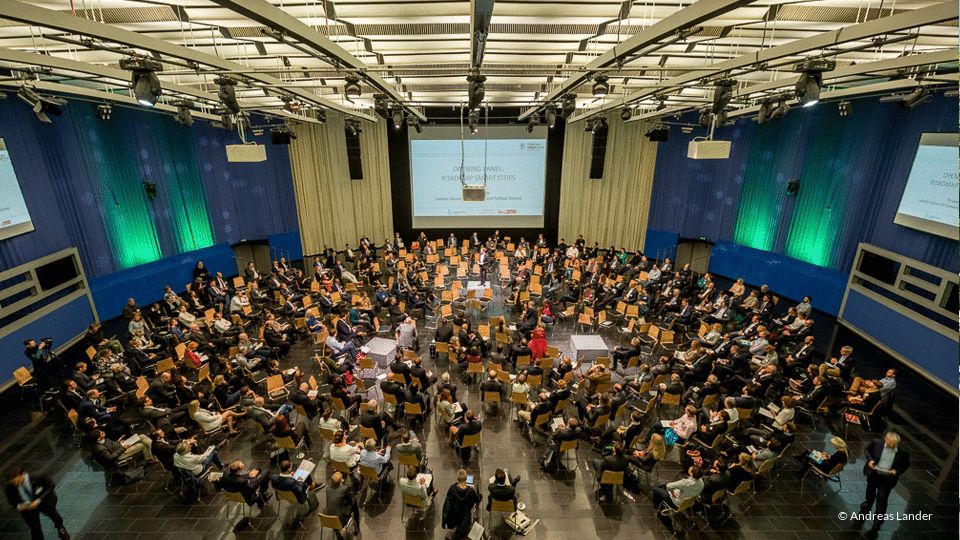This year’s Creating Urban Tech was not only about the technologies of the future. The 350 technology experts who attended also discussed the question of what role people will play in the smart city of the future.
The host, Ramona Pop, put it in a nutshell right at the beginning of Creating Urban Tech: technology and growth are not an end in themselves in urban development, said the Berlin Senator for Economic Affairs, Energy and Industry in her opening keynote. Instead, the focus is on how innovations can concretely improve people’s lives. As if Ramona Pop had given the cue with her opening statement, this year a conspicuous number of speakers at the Berlin Business Conference concentrated in their contributions on interpreting the smart core of the smart city far beyond what is technologically possible. If Jaakko Blomberg has his way, innovative urban development starts with a bit of civil disobedience. The Finn’s motto is “Never ask if you may!” Instead, Jaakko Blomberg just does it, and in this way initiated, for example, Restaurant Day, where four times a year so-called one-day restaurants attract Helsinki residents to the streets.
He has also launched a clear-out day, where Finns get rid of clutter and organise a large decentralised flea market. The special thing about it: Both ideas were quasi-illegal at the beginning, but the overwhelming response of the population quickly made the city administration take a closer look at Jaakko Blomberg and eventually even support him financially. Because he succeeds in doing something that many cities dream of: he makes sure that the inhabitants of Helsinki make the public space of their city their own again. And his projects also create something like an urban flair in which new ideas can emerge. The question of how cities can become better and how their inhabitants can also identify with this change in the city is not only posed by Jaakko Blomberg in Helsinki. For Elke Pahl-Weber, urban planning expert from the Technical University in Berlin, there is an admission at the beginning of good urban development: “We don’t know what the smart city will look like.
That is why she develops prototypes of the future city and discusses them with the people who will one day live in these cities. Because, says Pahl-Weber, if people are not involved in the planning of their cities, they usually reject the developments afterwards.
Philipp Bouteiller from Tegel Projekt GmbH underlined this approach with his plea “to get beyond technology in city planning”. He suggested that in future the city’s residents should be understood more as “users” of the cities, so that their expectations and wishes can be better integrated into the urban planning process. So far, however, this is still difficult in Berlin because, unlike Barcelona or Amsterdam, Berlin still knows relatively little about its citizens, according to Bouteiller. Philipp Rode from the London School of Economics explained that from an international perspective, Berlin has an exemplary involvement of its residents in urban development. Berlin enjoys an excellent reputation when it comes to the use of open spaces in the city by its residents. The many temporary use concepts that have existed in Berlin since the 90s are unique, said Rode. Many cities around the world envy Berlin for these spaces, because they have contributed to Berlin’s attractiveness for young people today.
The red-lit discus turns bicycles into e-bikes
In his keynote speech, Assaf Biderman from the Senseable City Lab presented the role that technical innovations can play in improving the quality of life in cities. Biderman and his team analysed the movement of New York taxis in Manhattan – and came to the conclusion that taxi traffic alone could be reduced by over 50 percent. A large part of the journeys are made on the same routes over and over again, only that very few taxis are fully occupied. If the demand for taxis were better coordinated, the notorious traffic in Manhattan could be significantly relieved. It is even more important, however, that the number of 1- and 2-passenger vehicles in the inner cities increases significantly. This is the only way to reconcile individual route preferences and the growing number of city dwellers. Biderman has even been directly involved in a product innovation in the 1-passenger vehicle sector that has caused a stir in recent months: the Copenhagen Wheel. Behind it is a wheel with a Danish-red shining discus in the middle. With the Copenhagen Wheel, conventional bicycles can easily be converted into e-bikes, making even longer distances in the city attractive for cyclists. Philipp Rode used a concise example from the field of mobility to explain that, in order to make the city of the future more liveable from the point of view of its inhabitants, fundamental thinking must first change. Up to now, people have usually developed the vehicles first and then thought about how best to adapt the city to their requirements. In future, according to Rode, it would be better to first clarify the fundamental question of how we want to live together in cities – and then all further planning should be guided by this consensus. More information on Creating Urban Tech 2017 can be found here.
